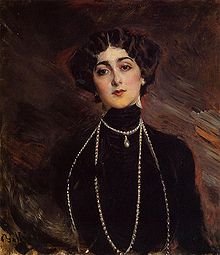Lina Cavalieri
[citation needed] At a young age, she made her way to Paris, France, where her appearance opened doors and she obtained work as a singer at one of the city's café-concerts.
The Russian Prince Alexander Bariatinsky was deeply in love with Lina, and they had an open affair, but never became husband and wife as his parents and Tsar Nicholas II himself strongly opposed this marriage.
[4][5][circular reference] In 1904, she sang at the Opéra de Monte-Carlo then in 1905, at the Sarah Bernhardt Theatre in Paris, Cavalieri starred opposite Enrico Caruso in the Umberto Giordano opera Fedora.
Frequently referred to as the "world's most beautiful woman", she was part of the tightlacing tradition that saw women use corsetry to create an "hour-glass" figure.
During her career, Cavalieri sang with other prominent singers, including Giuseppe Anselmi, Mary Garden (the world premiere of Massenet's Chérubin, 1905), Mattia Battistini, Titta Ruffo, Feodor Chaliapin, Nikolay Figner, Antonio Scotti, Vanni Marcoux, Giovanni Zenatello, Tito Schipa, and the French tenor Lucien Muratore, whom she married in 1913 after his divorce from soprano Marguerite Bériza.
Cavalieri was killed on 7 February 1944 during an Allied bombing raid that destroyed her home in Florence near Poggio Imperiale, where she had been placed under police surveillance because of her foreign husband.
In 1910, for Columbia, she recorded arias from La bohème, Tosca, Manon Lescaut, Carmen, Mefistofele, and Faust, as well as "Maria, Marì!
The latter painting is now the property of the Metropolitan Opera, the gift of Nicholas Meredith Turner in memory of his wife, the soprano Jessica Dragonette.
In 2004, a book was published, written by Paul Fryer and Olga Usova, titled Lina Cavalieri: The Life of Opera’s Greatest Beauty, 1874–1944.



